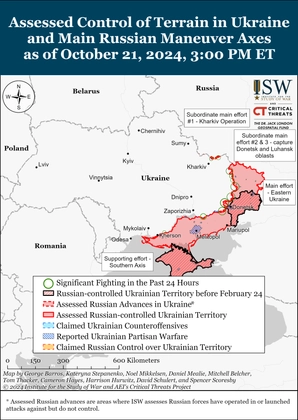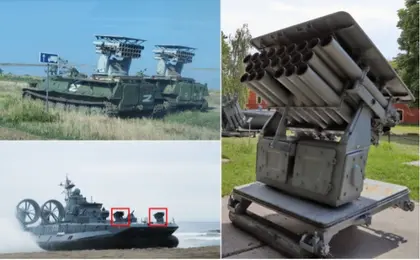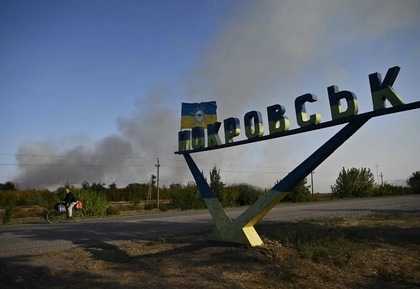Moscow’s desperation to replenish tanks and other equipment lost to Ukraine since the Kremlin launched its full-scale invasion is making itself apparent in the patchwork weaponry it’s now bringing to the front lines.
The phenomenon of Russian armored vehicles made up of old chassis on which had been grafted a variety of weapons, particularly naval ship-borne artillery systems, first appeared at the beginning of the year. It seemed to signify that Russia’s commanders, desperately short of battle-ready tanks or artillery, had turned to improvising “Frankenstein” tanks from spare parts to fill the gap in their armory.
JOIN US ON TELEGRAM
Follow our coverage of the war on the @Kyivpost_official.
Nineteen months into Russia’s aggressive war its losses in armor and other weapons systems have continued according to daily figures released by the Armed Forces of Ukraine (AFU). Recent sightings indicate that the Frankenstein factories are still churning out their whacky improvised “tanks.”
Most seem to utilize the MT-LB “multi-purpose tractor - light armored.” Introduced in the 1960s, it was originally used to tow howitzers and anti-tank guns into firing positions or to transport vital supplies or infantry to the frontline.
Its 14mm welded-steel armor gave the 13-ton vehicle protection against small arms fire while a medium-machine gun gave it some self-defense capability. It was designed to be amphibious and its 30 kph cross-country speed gave it all-terrain mobility.

ISW Russian Offensive Campaign Assessment, October, 22, 2024
It was never really intended to engage in direct combat, but the Russians desperate for anything with armor to support its so-called “special military operation”, regardless of how little protection it provides, have turned to the MT-LB as the base for a number of its bizarre contraptions.
It’s not only the fact that adapting the MT-LB is relatively simple – it was designed that way – it is the fact that there are hundreds of them lying about. Over 55,000 were produced, so it has become the go-to platform for bolting on all manner of weapons large and small.
Let’s have a look at some examples:
The less ridiculous
MT-LB conversions were particularly common amongst pro-Russian separatists in Donetsk and Luhansk following the 2014 illegal annexation. Some modifications included fitting the turret of a BMP-1 fighting vehicle and its 73mm low-pressure gun, the 2B9 automatic 82mm mortar and even a 2S9 NONA-S 120mm rifled gun-mortar [a rifled, breach-loaded mortar].
Growing more desperate
Images began to appear in social and in the mainstream media in February and March of crudely-engineered vehicles being deployed to Ukraine which showed a 1940s-era naval 25mm 2M3 anti-aircraft turret fitted to a MT-LB.
Military experts suggested that Moscow likely turned to a naval turret because its navy had been far less depleted than its land forces.
They probably had access to a sizeable number of them and their associated ammunition.”
Desperation grows further
In early June photographs began to circulate of MT-LBs fitted with naval A-22 Ogon 140mm multiple rocket launchers, which were normally installed on the Zubr-class hovercraft and other assault craft.
The Ogon is designed to provide covering fire for amphibious assault using the OF-45/OFD-45 (high explosive fragmentation) or the ZZh-45 (incendiary) unguided rockets with a maximum range of 4500 meters for OF-45 and ZZh-45 and 9000 meters for the OFD-45.

Rocket pods - now it’s becoming even more bizarre
Russian (and incidentally Ukrainian) vehicles consisting of an MT-LB hull to which has been grafted twin rocket pods (left photo below).
The pods were originally intended for use by combat aircraft and helicopters and can fire 80mm S-8 or 57mm S-5 unguided rockets.
Reports of the vehicles being used have been made this summer. The pods are likely to be used as an improvised area bombardment weapon, as a sort of mini-version of the BM-21 “Grad” 122mm multi-barreled rocket system, with a range of around 3 kilometers.

Another Russian version uses a single rocket pod on the front and a 2B9 Vasilek 82mm Gun-mortar fixed to the rear. The 2B9 mortar can fire high-explosive, armor-piercing, and smoke shells, as well as flares out to a range of about 4.2 kilometers.
Bizarre doesn’t do it justice
One of the most bizarre MT-LB / naval weapon mash-ups was captured by the milblogger KARYMAT who published a photograph on his Telegram channel of an MT-LB fitted with an RBU-6000 anti-submarine rocket launcher on a flatbed truck, apparently en route to the Ukraine front line on Saturday.

The RBU-6000 Smerch-2 is a 12 barreled 213mm Soviet vintage anti-submarine rocket launcher, which is considered to be a 1960s upgrade of the British WWII “Hedgehog” system. It is fitted to a wide range of Russian surface vessels.
It fires the 500-kilogram RGB-60 unguided depth charges out to a range of around 4 kilometers so, even if inaccurate, it can cause serious impact against even heavily protected targets.
No matter how preposterous these hybrid vehicles appear it should not be forgotten that they carry weapons that are designed to kill. The one saving grace is that in choosing the MT-LB as the weapons platform it makes them vulnerable to even relatively small caliber weapons.
You can also highlight the text and press Ctrl + Enter






